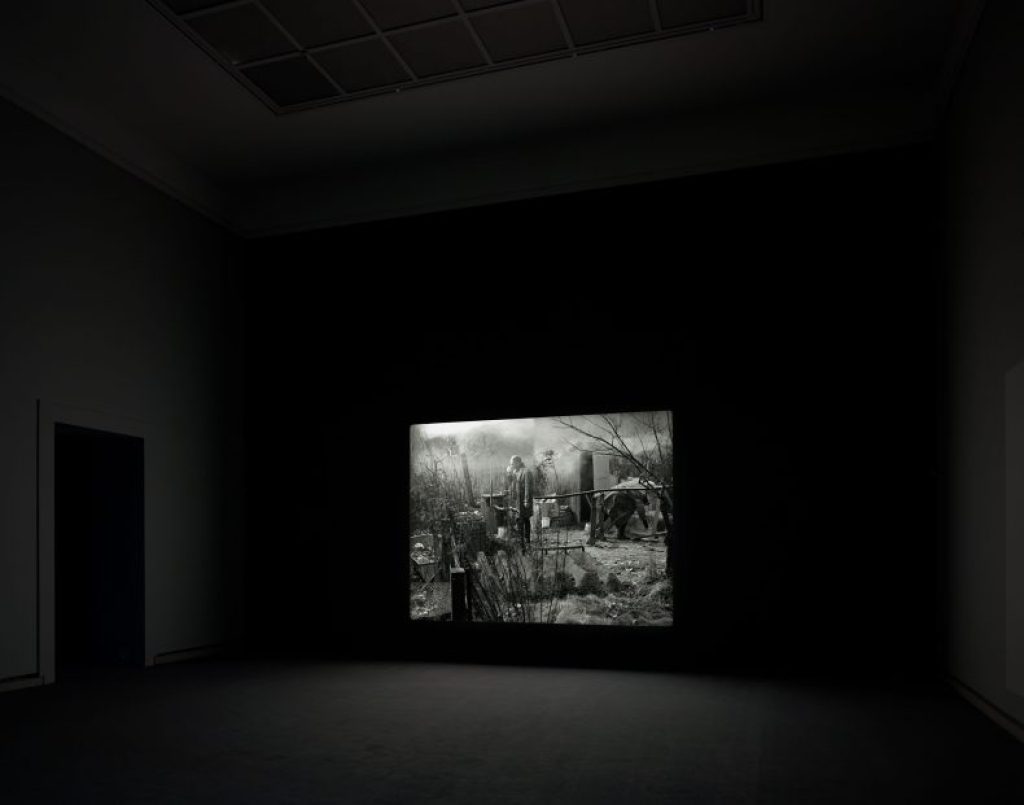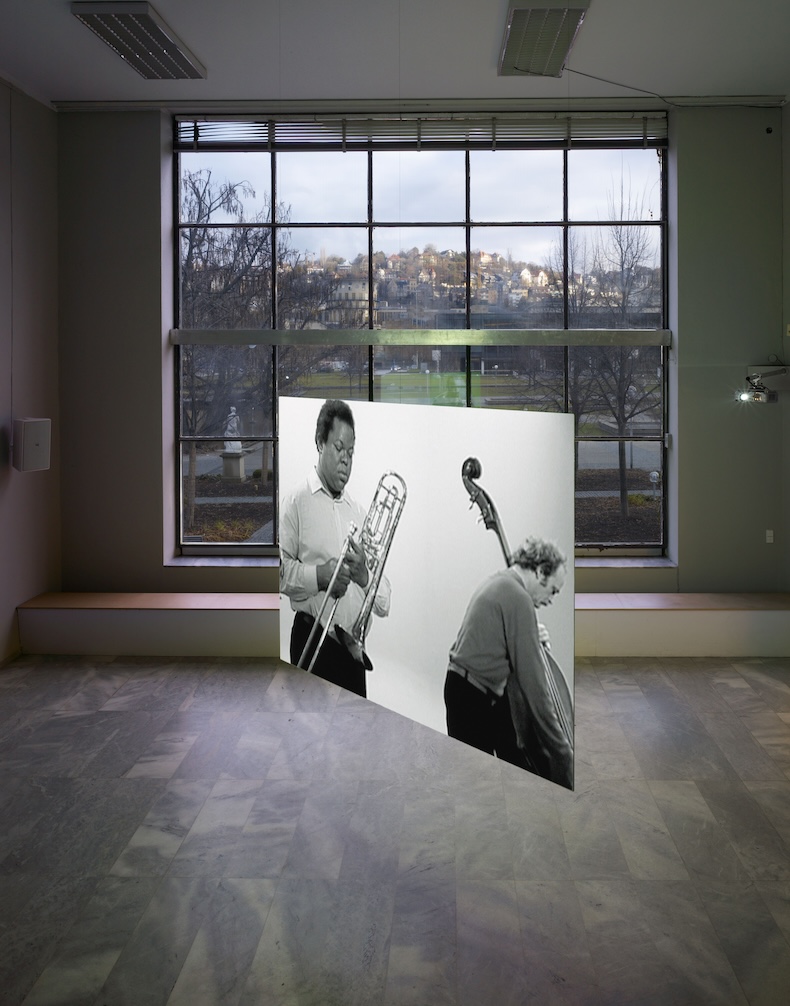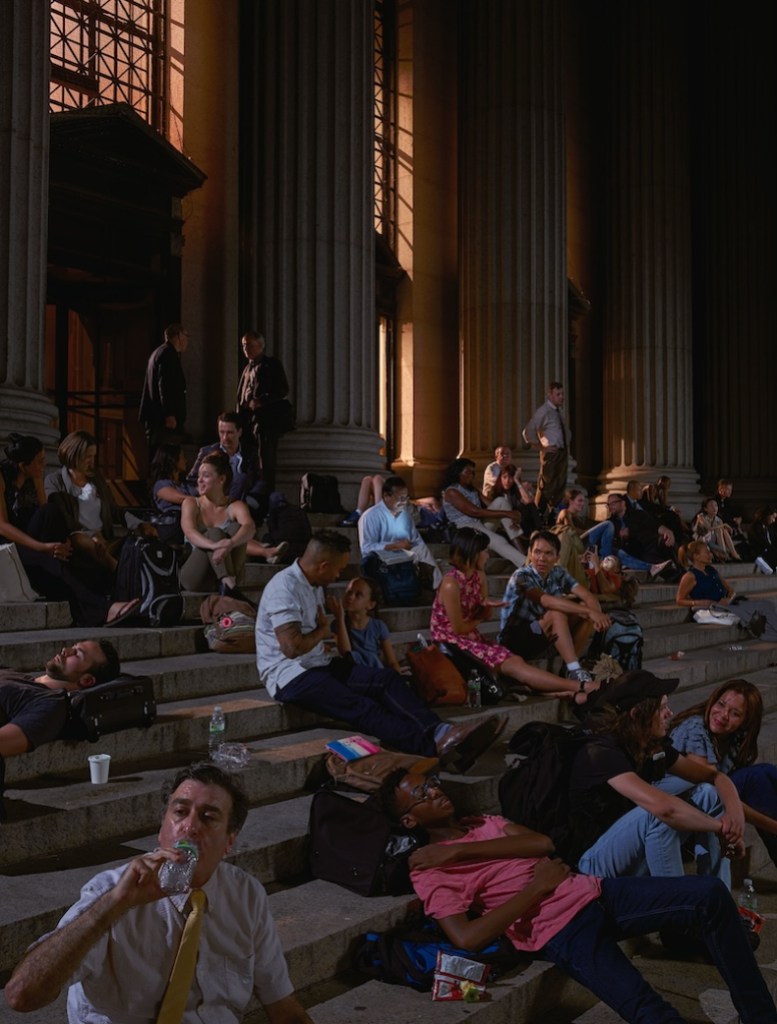From the October 2025 issue of Apollo. Preview and subscribe here.
In Der Sandmann (1995) by Stan Douglas, two 16mm projectors display a pair of looping, overlapping scenes: a Schrebergärten (allotment) in Potsdam, seen both at its fertile peak and as a despoiled, defoliated wasteland. As the cameras pan circles around the artist’s studio, the public garden, once a source of fresh food for working people in the GDR, transforms into private property and then back to common land, as a Black German man named Nathanael relates a story from his childhood about a strange gardener. Like the two panning feeds, his narration both does and does not line up with the story by E.T.A. Hoffmann that gives the piece its name. It generates an effect of convergence and disjuncture at the same time – between a garden which is also a piece of real estate, and a moment of political liberation which might lead, paradoxically, to the death of an entire world.
Der Sandmann is just one piece of ‘Ghostlight,’ a wide-ranging survey of Douglas’s work currently on display at Bard College’s Hessel Museum of Art. Spanning photography, digital collage, experimental video and a new five-channel installation riffing on D.W. Griffith’s film The Birth of a Nation (1915), these works attest to the artist’s decades-long interest in divergence: between the past and the present, the seen and the unseen, the world as it is described in official reports and public narratives, and as we experience it – and the possibility, however far-fetched, that one might be transformed, one day, into the other.

Douglas was born and raised in Vancouver, British Columbia, and a number of the works on display allude to the region’s history as a junction-point of varied imperial, commercial and social visions. In his photos of the Nootka Sound, Douglas traces the lives and afterlives of the island’s logging and quarrying industries, scars upon a landscape Europeans once considered untouched and unpeopled. The Nu*tka* installation of 1996 is a sonic and visual expression of this disjunction, isolating the audio tracks of Spanish and English explorers on to separate channels, while another pair of images pan past on screen. Where Der Sandmann places these feeds side-by-side, Nu*tka* digitally interlaces these views of the Sound into alternating hair-thin raster lines – one line Feed A, the next Feed B, the third Feed A, the fourth Feed B, from top of screen to bottom. Your eyes struggle to piece together a complete picture from these disjointed images, until suddenly they alight upon an identical view, and the screen comes into focus, and the voices speak in one voice, illustrating neatly how even divergent colonial interests and institutions serve ultimately the same master.
Throughout, Douglas prompts us to question the veracity of what we’re seeing, often by revealing what we do not. Der Sandmann’s rotating film loops seamlessly and surreally between eras, disorienting the viewer with its lack of cuts. Elsewhere, a twin video feed projects the professional edit of a 1992 free jazz performance on one side of a screen, while the other plays b-roll of the musicians pausing, breathing, blowing the spit out of their slides. A number of large-scale photographs of distinct historical moments reveal themselves as digitally assembled tableaux that blend documentary and staged photography – history reconstructed from memory and imagination.

This approach reaches a kind of apotheosis in the most recent work on show here, Douglas’s response to The Birth of a Nation, a racist epic that had a formative influence on the early development of Hollywood cinema. A central channel plays one sequence from Griffith’s film, in which a young white woman, Flora, is proposed to and then menaced by a freed black Union Army captain named Gus, played by a white man in blackface. When Flora commits suicide, Gus is chased down and arrested by a group of self-deputised Klansmen, who lynch him off-screen.
Douglas breaks this scene out across four other screens, playing out the sequence from a variety of perspectives, from the everyday routines of the Klavern (the local branch of the Ku Klux Klan) to the lives of free Black men, trapped in a south where slavery has recently been defeated, yet white rule remains strong. He is showing us what Griffiths does not: that bigotry is structural, not situational; that it inheres in communities and always carries the likelihood of violence. In the process, he reveals and dissects the manias and delusions undergirding Jim Crow, the seductive, convenient narratives that could transform a romantic suitor into a demonic menace and the lynching of an innocent man into an act of world-historical heroism.

Yet it’s not all loss at the Hessel. I was most struck by a small gallery hung with works from Douglas’s ongoing Crowds and Riots series. Digitally assembled from documentary sources and figures posed in the studio, these tableaux re-stage moments of possibility and of conflict, from race meetings to sports riots, with a focus on political gatherings. From trade-union strikes to the London riots of 2011, which began in the protests against the killing of an unarmed black man by the police, these photographs demonstrate how easily the shackles of expectation and moderation can slip away, how much power can accrue when people collect themselves, gather together and push back.
These magic actions, as the critic Tobi Haslett calls them, put pressure on the joints between the stated and the actual, revealing in the process how flimsy the established order really is. Not that we can predict what will emerge from that rupture: the effect might be progress, or the restoration of an earlier, worse order. Yet as Douglas illustrates time and again, no result is preordained. Again and again throughout ‘Ghostlight’, I found myself smack in that decisive moment, when what might be gives over to what is. Whether through recreation, juxtaposition or disjuncture, fixed in a print or recursively projected, Douglas’s work makes those possibilities seem possible again, as if the clock has wound back, the film reset. Like Der Sandmann’s twin projectors, he holds you on both sides of that moment at the same time, panning and panning, searching for the changeover.
‘Stan Douglas: Ghostlight’ is at the Hessel Museum of Art, Bard College, Annandale-on-Hudson until 30 November.
From the October 2025 issue of Apollo. Preview and subscribe here.
